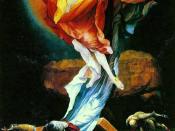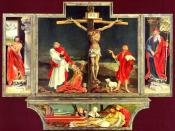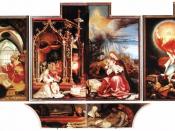The late fifteenth and early sixteenth century saw the birth of two artist that were so drastically different in styles, they are still looked at in awe over 300 years later. Albrecht Durer and Matthias Grunewald each had their own style and influence in the way they completed their art. Durer remained essentially German; the influence of the art of Italy and the Netherlands was accompanying. Grunewald rejected Renaissance style and followed the path of traditional northern religious themes. Both men show remarkable examples using color, light, and true naturalism to their art.
Among Durer's portfolio include such works as "The Fall of Man", which depicts Adam and Eve in the Garden of Eden committing the first sin, the "Prodigal Son", showing natural emotion and simplicity, the "Adoration of the Magi" which bears comparison with the masterpieces of Italy and the Netherlands. Durer's own woodcuts have a quality entirely their own.
"The Apocalypse" is notable by its expressiveness for the gruesome way it portrays demons. The most striking of the series are the "Four Riders", the "Angels of the Euphrates", and the "Battle of the Angels with the Dragon". Durer brought Wood and copperplate engraving to great perfection.
In "The Festival of the Rosary", painted in Venice along with "Christ on the Cross" and "Adam and Eve", his influence from Italian colorists can be seen. During this time, he had made the acquaintance with Giovanni Bellini and the influence can be remarkably seen in his work. In 1511 Durer produced the "Virgin with the Pear", one of the finest of his Madonna's. In the years 1513-14 he executed three great copperplate engravings: these may, perhaps, be looked upon as ideal representations of a fearless knight, an unsatisfied searcher for knowledge, and a saint happy in God and are called: "The...


